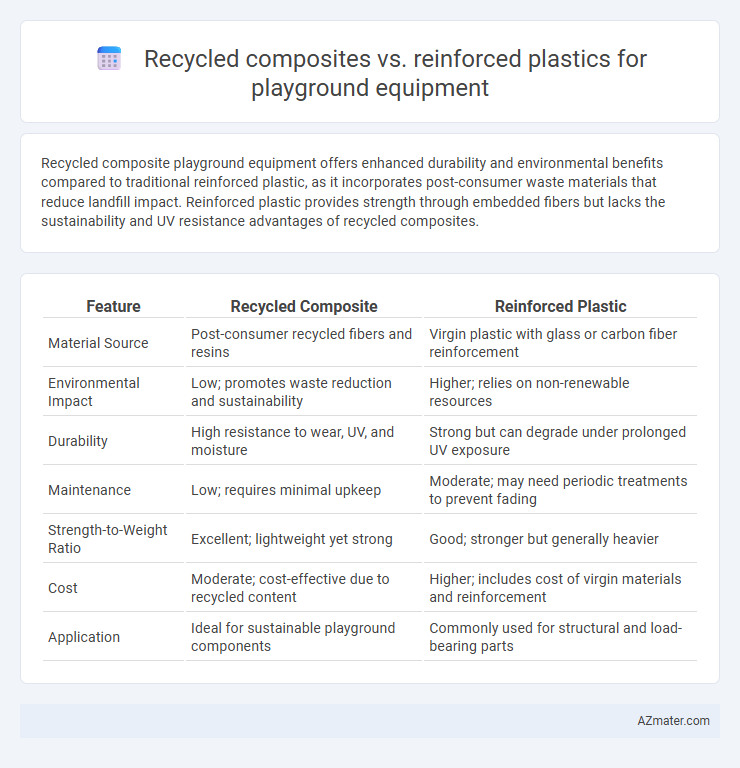Recycled composite playground equipment offers enhanced durability and environmental benefits compared to traditional reinforced plastic, as it incorporates post-consumer waste materials that reduce landfill impact. Reinforced plastic provides strength through embedded fibers but lacks the sustainability and UV resistance advantages of recycled composites.
Table of Comparison
| Feature | Recycled Composite | Reinforced Plastic |
|---|---|---|
| Material Source | Post-consumer recycled fibers and resins | Virgin plastic with glass or carbon fiber reinforcement |
| Environmental Impact | Low; promotes waste reduction and sustainability | Higher; relies on non-renewable resources |
| Durability | High resistance to wear, UV, and moisture | Strong but can degrade under prolonged UV exposure |
| Maintenance | Low; requires minimal upkeep | Moderate; may need periodic treatments to prevent fading |
| Strength-to-Weight Ratio | Excellent; lightweight yet strong | Good; stronger but generally heavier |
| Cost | Moderate; cost-effective due to recycled content | Higher; includes cost of virgin materials and reinforcement |
| Application | Ideal for sustainable playground components | Commonly used for structural and load-bearing parts |
Introduction to Playground Equipment Materials
Playground equipment materials include recycled composites and reinforced plastics, each offering unique durability and environmental benefits. Recycled composites, made from reclaimed wood fibers and plastic, provide sustainability by reducing waste and resisting weathering and rot. Reinforced plastics, often fiberglass-based, deliver high strength and impact resistance while requiring minimal maintenance for long-term outdoor use.
Overview of Recycled Composite Materials
Recycled composite materials for playground equipment combine reclaimed plastics, wood fibers, and other post-consumer waste, offering enhanced durability and environmental benefits compared to traditional reinforced plastics. These composites resist weathering, splintering, and insect damage while reducing landfill waste and carbon footprint. Their structural integrity and low maintenance requirements make them a sustainable alternative widely adopted in playground construction.
Understanding Reinforced Plastics
Reinforced plastics, commonly used in playground equipment, combine a polymer matrix with structural fibers like fiberglass or carbon fiber to enhance strength and durability. These materials offer superior resistance to impact, weather, and chemical exposure compared to standard plastics, ensuring long-lasting safety and performance. Understanding the mechanical properties and environmental resilience of reinforced plastics is essential for selecting materials that meet stringent playground safety standards.
Environmental Impact: Sustainability and Recycling
Recycled composite playground equipment significantly reduces landfill waste by incorporating post-consumer plastics and reclaimed wood fibers, enhancing sustainability through resource conservation. Reinforced plastic, while durable, often relies on virgin materials and can be challenging to recycle due to mixed resin compositions, contributing to environmental concerns. Prioritizing recycled composites supports circular economy principles by enabling easier recycling processes and lowering carbon footprints associated with raw material extraction.
Durability and Lifespan Comparison
Recycled composite playground equipment exhibits superior durability due to its resistance to moisture, UV radiation, and physical wear, often lasting 20-30 years with minimal maintenance. Reinforced plastic, while strong and lightweight, tends to degrade faster under prolonged sun exposure and harsh weather, resulting in a lifespan typically around 10-15 years. The enhanced structural integrity and environmental resilience of recycled composites make them a more sustainable and long-lasting choice for playground installations.
Safety and Toxicity Considerations
Recycled composite materials for playground equipment offer enhanced safety by minimizing splinters and sharp edges, coupled with non-toxic, environmentally-friendly components that reduce exposure to harmful chemicals. Reinforced plastic often contains additives such as phthalates and BPA, which raise concerns about long-term toxicity and potential health risks in children. Prioritizing recycled composites ensures compliance with safety standards and lowers the risk of chemical exposure, making them a superior choice for child-focused play environments.
Maintenance Requirements and Costs
Recycled composite playground equipment requires significantly less maintenance than reinforced plastic due to its enhanced durability and resistance to moisture, UV rays, and insect damage. The initial cost of recycled composites is typically higher, but long-term maintenance savings and extended lifespan reduce overall expenses compared to frequently repaired or replaced reinforced plastic components. Budget allocation for playground upkeep favors recycled composites by minimizing annual repair costs and reducing the need for specialized upkeep products and labor.
Aesthetic and Design Flexibility
Recycled composite materials offer enhanced aesthetic appeal and design flexibility for playground equipment compared to reinforced plastics, featuring a broader range of color options, textures, and finishes that mimic natural wood or stone. These composites allow for seamless molding into intricate shapes and custom designs without sacrificing durability or structural integrity. Reinforced plastics, while strong, often have limitations in texture variation and require additional surface treatments to achieve comparable visual and tactile effects.
Installation and Structural Performance
Recycled composite playground equipment offers superior installation ease due to its lightweight nature and pre-fabricated modular components, reducing labor costs and time on-site. Reinforced plastic, while durable, often requires specialized tools and more complex assembly processes, impacting installation speed. Structurally, recycled composites provide enhanced load distribution and resistance to environmental degradation, ensuring long-term safety and performance under heavy usage compared to conventional reinforced plastics.
Cost Analysis: Initial Investment and Long-term Value
Recycled composite playground equipment generally requires a higher initial investment compared to reinforced plastic due to advanced material processing and durability features. Reinforced plastic offers lower upfront costs but may incur higher maintenance and replacement expenses over time. Long-term value favors recycled composites as their resistance to weather, impact, and UV degradation reduces repair costs, extending lifespan and overall return on investment.

Infographic: Recycled composite vs Reinforced plastic for Playground equipment
 azmater.com
azmater.com